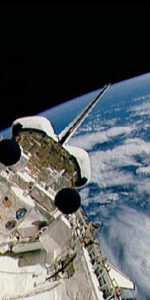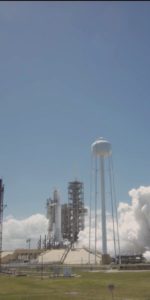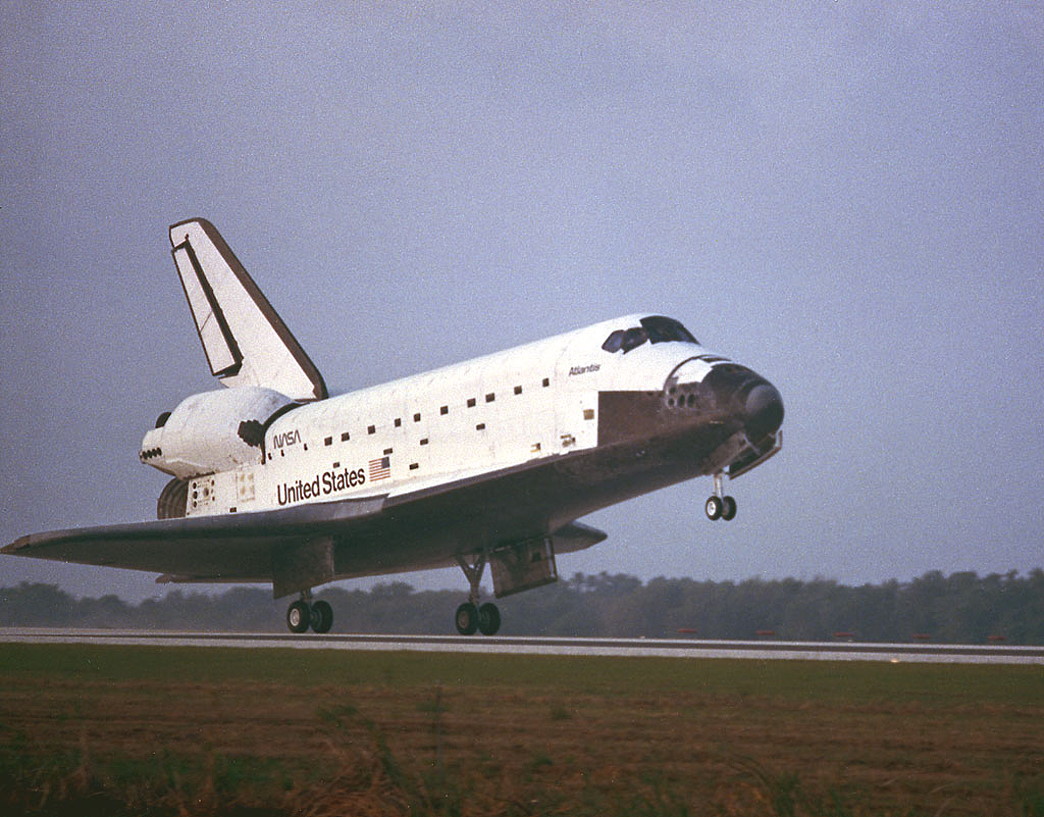
Twenty-five years ago, this week, seven individuals from three sovereign nations—five Americans, the first Belgian citizen to enter space and a British-born astronaut—orbited Earth aboard Space Shuttle Atlantis. Their STS-45 mission carried a battery of experiments in the payload bay, known as the Atmospheric Laboratory for Applications and Science (ATLAS). It was hoped that ATLAS-1 would be the first of ten or more such missions, spanning a full 11-year solar “cycle”, to monitor atmospheric chemistry, solar and space plasma physics and ultraviolet astronomy. As circumstances transpired, only three ATLAS missions actually took place, but they contributed immensely to our understanding of the Home Planet and its interaction with the parent star which gives it life.
As described in yesterday’s AmericaSpace history article, the flight originated long before the calamitous loss of shuttle Challenger and might have flown in mid-1986 as the first Earth Observation Mission (EOM). Subsequently redesigned and rescoped, it rose from Pad 39A at the Kennedy Space Center (KSC) in Florida on 24 March 1992, bound for nine days of around-the-clock research. Within minutes of achieving orbit, the “blue shift” of Commander Charlie Bolden, Pilot Brian Duffy, Payload Commander Kathy Sullivan and Payload Specialist Dirk Frimout set to work activating the ATLAS-1 payload, whilst their crewmates on the “red shift”—Mission Specialists Dave Leestma and Mike Foale and Payload Specialist Byron Lichtenberg—bedded down for their inaugural sleep shift.
Inclined at 57 degrees to the equator, Atlantis’ 90-minute orbit carried her as far north as Juneau in Alaska and a little farther south than Tierra del Fuego, at the southernmost tip of Argentina. This enabled atmospheric physicists to gather data from the tropics to the auroral regions and over diverse geographical areas, from rainforests to deserts and from oceans to landmasses. Mounted on a pair of Spacelab pallets were 12 scientific instruments to support 14 experiments from the United States, France, Germany, Belgium, Switzerland, the Netherlands and Japan. Several were scheduled to be reflown on subsequent ATLAS missions. “Reuse of these facilities,” noted NASA’s ATLAS-1 press kit, “also will allow scientists to expand their base of knowledge to provide a more accurate, long-term picture of Planet Earth and its environment.”
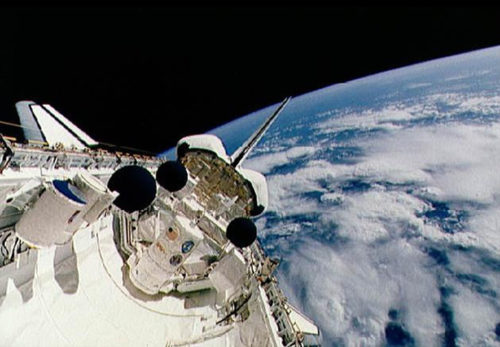
These included a far-ultraviolet space telescope, a trio of instruments to track the amount of solar energy received by Earth’s atmosphere, a pair of spectrometers to examine gas abundances in the stratosphere, mesosphere and thermosphere and a set of black spheres, which formed the Space Experiments with Particle Accelerators (SEPAC). The latter, designed by Japan, included an electron “gun” to investigate the charged-particle dynamics of the ionosphere. During STS-45, it emitted a stream of xenon plasma to “clamp” the electrical potential of the shuttle to the plasma potential of the upper atmosphere, as part of efforts to better understand aurorae and magnetic and electrical fields.
“We were all pretty jazzed up about this,” said Sullivan. “The idea was to have the orbiter oriented so that the aperture of the instrument would inject these electrons roughly along the magnetic field line down towards the atmosphere, near the polar regions.” It was, in her words, a “dose-response” experiment; injecting a known dose of energy into the atmosphere and measuring the brightness of the resultant aurora-type glow. “If I know I put in this many kilowatts of energy and I measured that luminosity,” she reasoned, “maybe I can start to get a clearer understanding of how the energy of the incoming solar particles couples into the atmosphere and creates auroral luminescence.” Several other experiments ran in tandem with SEPAC, examining atmospheric constituents, trace molecules and gaseous emissions.
Neither of the two 12-hour teams saw themselves to be in “competition” with the other. “Charlie didn’t ever really use such a device like that to drive performance,” remembered Sullivan. “Commitment to each other, commitment to the mission [were] the intrinsic factors that he exemplified and reinforced. He wouldn’t have needed to set up some fake game for me to make me do anything better.” Leestma, who was in charge of the red team, broadly agreed, although he admitted to some light-hearted competition during training. “Maybe one day,” he told the NASA oral historian, “the red team has their sim and the blue team has it the next day. When you’re done, you ask your training team: “Well, how did we do compared to those guys?” There’s always that natural competitiveness.”
The rear of the shuttle’s flight deck was a hive of activity during both shifts, packed with hand-held cameras, photomultipliers and filters. Twenty-four hours into the mission, the first firing from the SEPAC electron gun was scheduled to occur in the early stages of a red shift. “Us Blue guys were all down below” in the middeck, recalled Sullivan, “mucking around with dinner and starting to get changed for sleep. We knew it was coming and we were eager to see it, but we thought we should get out of their way, let them get set up for this and get into this.”
All at once came a cry from upstairs: “Oh my God, look at THAT!”
“There’s a cardinal rule on spaceflights,” said Sullivan, “which is “There shall be no sentences from the flight deck ending in that”, as in “What the hell was that?”, because you’ll terrify the guys down below, who can’t see anything.” As a consequence, the Blues floated up to Atlantis’ flight deck to witness the first firing. It was one of few successful demonstrations of the experiment. The spectacle reminded Sullivan of something from a sci-fi movie, as an oscillating blue blob of energy lingered atop the SEPAC canister and abruptly shot into the upper atmosphere.
“It goes by quickly,” she recalled. “It was starting to curve away. You could see the curvature of the magnetic field line. You could just see it begin to spiral along. All this material you drilled into your head in college physics…and now you’re seeing, in front of your eyes, the curvature of the magnetic field lines, the electron gyro-radius as this thing spirals around it.” The red team’s exclamation was surely understandable when faced with such a captivating sight. SEPAC reminded Leestma of a phaser or some futuristic space gun from Star Wars. Interestingly, the STS-45 crew participated in the presentation of the Irving G. Thalberg Memorial Award to Star Wars creator George Lucas whilst in orbit. They also carried a real Oscar statuette aboard Atlantis.
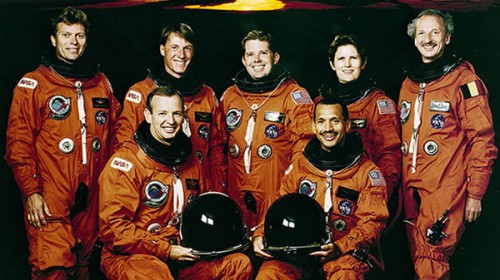
Although Sullivan admitted to being a fan of Lucas’ films, she admitted that “our photon torpedoes”, from SEPAC, “were much better!” Yet they were not quite as long-lived. Without warning, on only its second or third firing, SEPAC’s electron beam assembly abruptly arced and shorted out. “The fuse died,” Sullivan concluded, grimly. “They got two or three doses off. We were distraught.” However, the SEPAC team announced that the data already gained was more than sufficient for their research needs. Despite the disappointing loss of SEPAC, the remainder of the ATLAS-1 mission proceeded without incident and produced spectacular results. Atmospheric science stations as far afield as India, Indonesia, Japan and New Zealand made joint observations with the shuttle.
Exceptionally economical use of cryogenic consumables meant that on 29 March the Mission Management Team (MMT) opted to add an extra day in orbit. The mission was therefore extended from eight to nine days, with return to Earth rescheduled for 2 April. The hour-long re-entry back to the Kennedy Space Center (KSC) in Florida on that day came as a surprise to Duffy. “Coming back in, pretty much all at night,” he told the NASA oral historian, “because we were going to land just after dawn in Florida, so the whole thing was in the dark.” This fact alone generated a spectacular return to Earth.
Periodically, Duffy’s gaze would flicker from his instruments and over to the dramatic fire show underway outside his window: the nose glowed carnation-pink and it seemed that Atlantis was surrounded with a yellow and orange blaze. Every so often, he would look over at Charlie Bolden, watching his gauges, and would realize how different the real thing was from the simulator. “The biggest surprise, however, was physically,” Duffy said, “and part of it was because…it was the first time in which I’d gone to extended weightlessness to now back into the G-field, into gravity, and it’s not just to 1 G—it’s to 1.4 or 1.5 G—and it’s sustained for a long period of time and you’re coming in at a 40-degree angle. I actually had to put my hand on the glare shield and hold my torso up to keep it from slumping down and forward during the entry.”
It has often been remarked that the pilot’s key role at the end of a mission was to deploy the landing gear. “I’m calling altitudes and airspeeds to [Bolden] as we’re coming in for the final approach,” Duffy said, “because a lot of things are happening very quickly.” At 6:23 a.m. EDT, a little under nine full days since leaving the Cape, Atlantis’ tires touched Runway 33 of the Shuttle Landing Facility (SLF). In so doing, the first “Mission to Planet Earth” returned home to the bosom of the good Earth.
This is part of a series of history articles, which will appear each weekend, barring any major news stories. Next week’s article will focus on the 20th anniversary of STS-83, a shuttle mission in April 1997 which was forced to return home early, due to mechanical troubles.
Be sure to “LIKE” AmericaSpace on Facebook and follow us on Instagram & Twitter!




